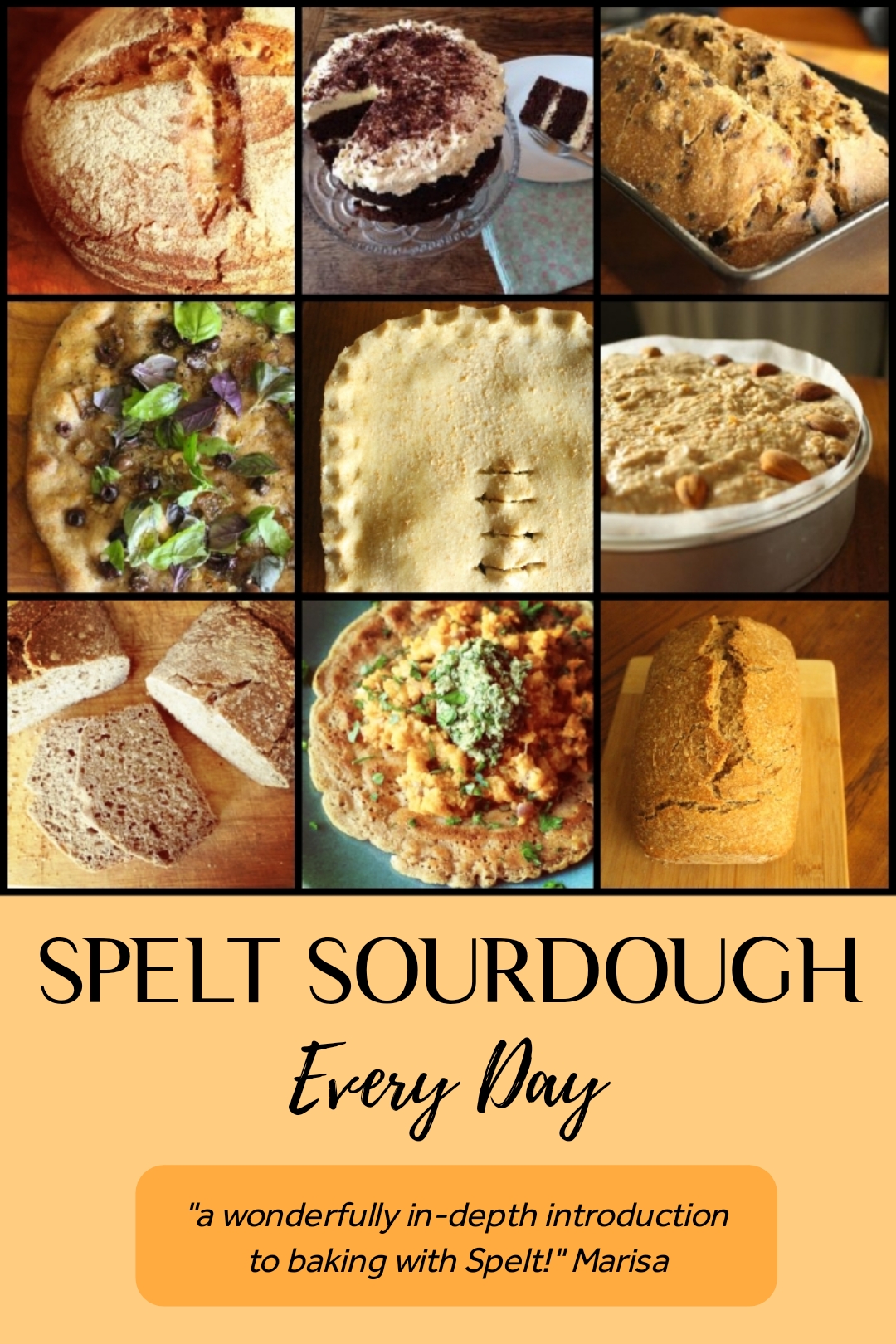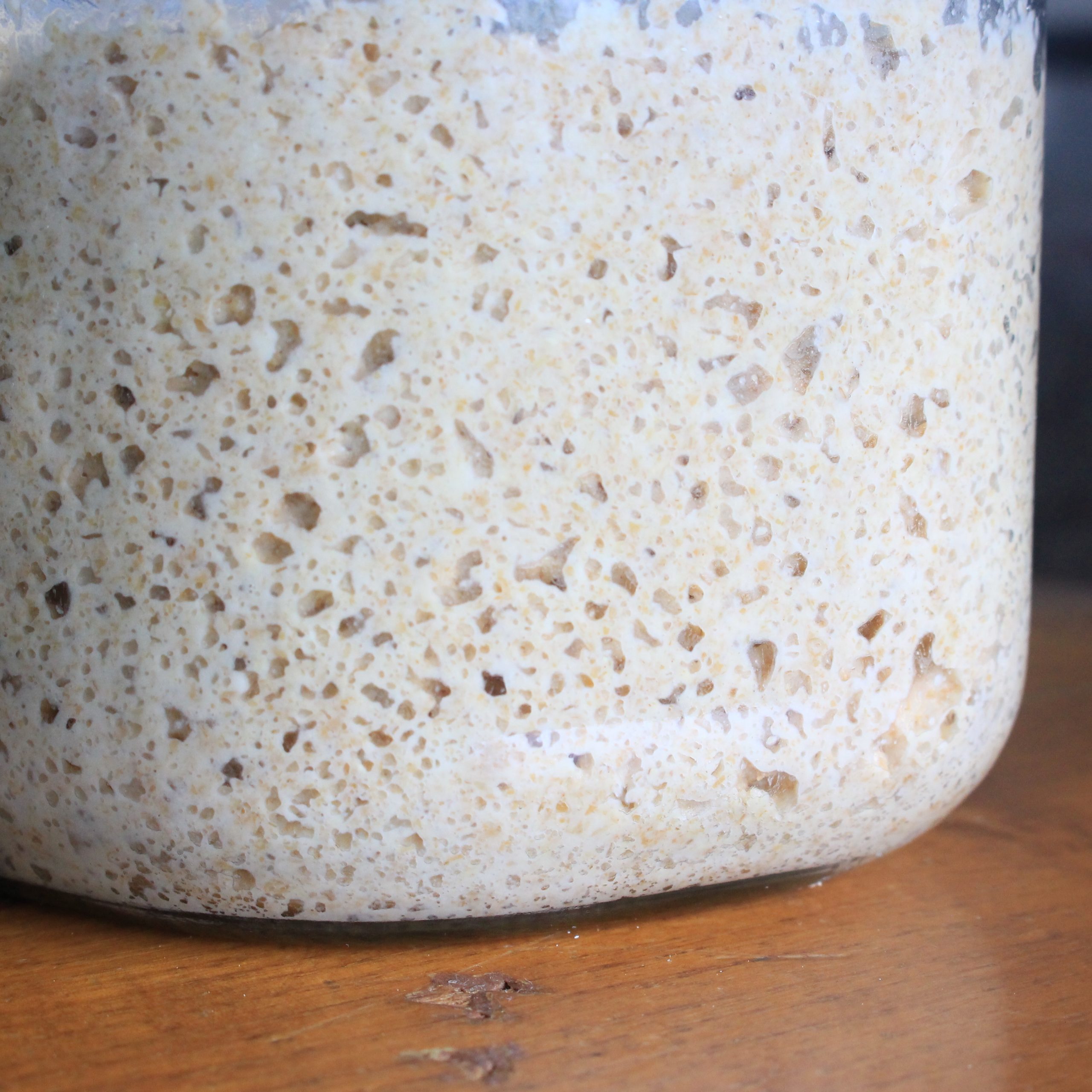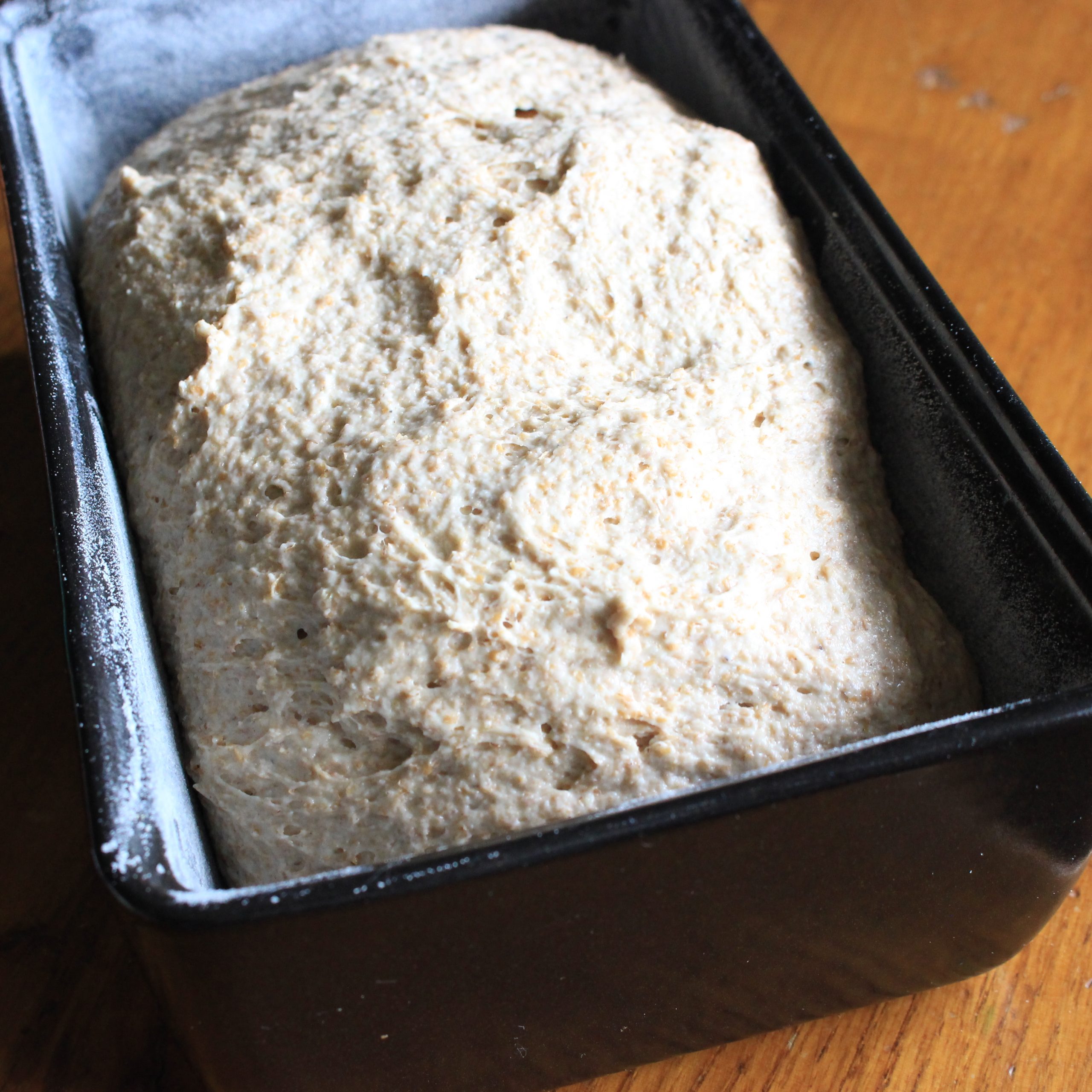Wholegrain sourdough spelt bread tastes amazing, but it quickly goes stale. Here’s a sourdough recipe made from 100% wholegrain spelt flour that won’t go stale!

When I first started teaching myself sourdough baking, I was determined to work with the nutty, ancient grain spelt and not leave out any of its bran. I wanted a well-risen, easy-to-make, wild yeast loaf which was soft in the middle and crusty on the outside.
Spelt tastes great, but it easily goes stale
After a few months, I had beautiful loaves that tasted great, but they’d go stale very quickly. I tried to find solutions – most people online suggested freezing the loaf, but (you’ll know, if you’ve tried) fresh spelt sourdough doesn’t taste so good when it has been in the freezer.
The answer: a scald
I carried on experimenting and hit on an answer: adding a scald – a portion of flour cooked in water – to the dough. This made the bread even softer, and stopped the problem with it going stale.
SInce that discovery, I have made this bread every week. it has become a joyful, delicious staple in our home. It is wonderful fresh, slices really well, keeps and copes with being frozen better than standard spelt sourdough.

Download a .pdf file of the recipe here.
Want more wholegrain spelt sourdough recipes?
Since creating this recipe, I’ve gone on to make spelt one of the foundations of my ancient grain baking. If you’d like to learn how to use spelt to create sourdough staples and treats in your own kitchen, you can find my recipes in my ebook Spelt Sourdough Every Day.

Wholegrain Spelt Sourdough Bread (that won’t go stale!)
You will need a 1kg loaf tin and an active sourdough starter. (See my post How to Create a Sourdough Starter for guidance if you need it.)
I build my sourdough levain for this bread the night before I want to bake. I then make the scald and mix the dough the next morning, ferment during the day and bake that afternoon. These timings can be played with depending on your schedule and the temperature of your house.
The night before:
Build your sourdough levain
45g wholegrain spelt flour
32g non-chlorinated water
13.5g active sourdough starter
- Mix these well and leave them in a warm place overnight. (If you need help, check out my article called How to Keep Your Sourdough Starter Warm.)

The next morning:
Make the scald
48g wholegrain spelt flour
192g non-chlorinated water
- Put both of these ingredients in a saucepan on medium to high heat and stir the mixture continuously, with a whisk or wooden spoon, until it starts to really thicken.
- Turn the heat down to low and continue to stir well for another few minutes – you are looking for a thick mixture that is not lumpy. Protocol suggests this mixture should reach 65C/150F. In practice I have found that cooking for 4/5 minutes will do this. Once done, leave this to cool.

Make the dough
507g wholegrain spelt flour
11g salt
196g non-chlorinated water
optional: 1 tbsp honey
- Mix the salt into the flour in a large bowl.
- Add your sourdough levain (which should be peaking or have just peaked), the water, the optional honey and the cooled scald. Mix until well combined using your hands.
- Cover and leave to bulk ferment in a warm place. The dough should increase in size by sixty to seventy percent. In the summer, for me, this takes three hours, in the winter, five.
- At the end of the bulk ferment period, grease and flour your baking tin.
- Gently tip the loaf out on to a floured board and shape it to fit your tin.
- Place into the tin, cover and leave to prove in a warm place until visibly risen. In my warm house this usually takes between an hour and an hour and a half.

Baking in a metal loaf pan:
Preheat your oven to 230C/445F. Brush the loaf with water and cook at 230C/445F for fifteen minutes, then reduce the temperature to 210C/410F for another fifteen minutes, finally turning the temperature to 190C/375F for a further thirty minutes. After this time, take the loaf out and check whether it is done by either tapping the bottom and listening for a hollow sound or using a probe thermometer and looking for a temperature of c. 90-95C/194-203F.

Baking in a ceramic lidded pan:
I love baking this loaf in my Emile Henry ceramic loaf tin (pictured above) which has a lid. If baking in lidded ceramic here’s what to do: Preheat your oven to 210C/410F. Brush the loaf with the water and cook at 210C/410F for fifteen minutes, then reduce the temperature to 190C/375C for the remaining cooking time of c. forty-five minutes. After this time take the loaf out and check whether it is done by either tapping the bottom and listening for a hollow sound or using a probe thermometer and looking for a temperature of c. 90-95C/194-203F.
You might also like:
Podcast episode: All About Spelt Sourdough (You can also find this on your podcast player by searching for Ancestral Kitchen Podcast)
5 Reasons to Start Baking with Ancient Grains
How to Make Sourdough Rye Bread From Scratch

Bring ancient grain baking into your kitchen!
Download my free 30-page guide with five healthy and tasty 100% ancient grains recipes.


I live in Oregon, USA, and saw this recipe linked on Elly’s video. I love Spelt and look forward to giving this a try! I also look forward to checking out the rest of your blog for ideas. Thank you for the recipe!
Hi Lori and thanks for your note! Glad you found me – I was super-grateful to Elly for baking up my loaf. I love her breads. Amazing that we’ve covered Italy, Auz and the US with the connection! Let me know how you get on with this recipe 🙂
I’m making this loaf this morning, and just noticed that your recipe doesn’t mention any kneading or other explicit gluten development. Does it need any?
Hi Deane. There’s no need to knead the loaf – just make sure you mix the ingredients really well at the start. When I do it that means about 5 minutes of working to combine. I’d love to hear/see how you get on! Alison
Good morning!
I found you through Elly’s video and tho I have some spelt grains arriving via Azure this week, I am wondering if this recipe translates well for freshly milled white or red hard wheat. Currently, I only have a hand grain mill, but am hoping to purchase a Mockmill 100 when I can afford it.
Thank you!
Cindy
Hi Cindy,
I have never tried it with wheat, but I’m sure it’d work. Elly made this loaf with freshly milled spelt – the only thing I’d say to pay attention to with a different grain or freshly-milled is the water, you may need more. I have a hand-grinder too 😉
Happy baking!
Alison
Hi Ali and greetings from Texas!
I want to give this a go soon. You give instructions for baking in metal or ceramic vessels. How about stoneware?
Thanks for sharing all your knowledge hard work.
Hi Susie,
I have never baked this (or anything else) in stoneware. The closest I have to that is ceramic. I would suggest foremost following your own experience with the pan. Think about how you bake other loaves and work from there. If you can have a higher temp for the first 15 mins, it will help with oven spring.
I’m curious to hear how it goes. Let me know 🙂
Hi Alison! I am trying this out for the first time! I’ve got it in the loaf pan for the second rise and I’m nervous because the dough looks and feels so dense. Also it feels both dry and sticky at the same time, if that makes sense. Is it how this spelt bread dough should feel like?
Hi Christine, I’m guessing it’s baked by now. This bread, with its scald, will be denser than a ‘normal’ wholegrain spelt loaf but, from the description of your dough, it sounds as though your flour is more thirsty than mine. When trying again, I’d use 15% more water and see what changes. Using a pan you have the flexibility to go further on the hydration to get a better-risen loaf.